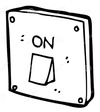Anxiety Disorders Flashcards
What are 3 potential symptoms of anxiety?
palpitations
sweating
dry mouth
difficulty breathing
chest pain
nausea / butterflies in stomach

What are 2 potential types of anxiety disorders?
- generalised anxiety disorder
- (persistent anxiety about a variety of things)
- social phobia
- specific phobias
- (e.g. arachnophobia)
- panic disorder
- (discrete episodes of panic)
- obsessive compulsive disorder (OCD)
- post traumatic stress disorder (PTSD)

Are GABA levels increased or decreased in the cortex of patients with anxiety disorder?
decreased GABA levels
GABA is an inhibitory neurotransmitter
Why should benzodiazepines not be used long term for anxiety disorder?
dangerous in overdose
risk of addiction or tolerance
Which 3 key structures form the limbic system?
Hippocampus
Hypothalamus
Amygdala

What is the function of the hippocampus?
involved in the formation of memories and suppression of the HPA axis

What is the function of the amygdala?
play a key role in the processsing of emotions (especially fear)
major outputs to the cortex and hypothalamus

How can anxiety lead to excess cortisol in the body?
simulation of the limbic-hypothalamo-pituitary-adrenal axis

Whare are the two common treatment options for anxiety disorders?
Selective Serotonin Re-uptake Inhibitors
(SSRIs potentially increase the sensitivity of glucocorticoid receptors in the hippocampus to suppress the HPA axis)
Cognitive Behavioural Therapy

What is an obsession in the context of psychiatry?
thought that persists and dominates and individuals thinking, despite awareness that the thought is without purpse and has persisted beyond the point of usefulness
What is a compulsion in the context of psychiatry?
obsessional motor act resulting from an obsessional impulse, or mediated by an obsessional mental image
e.g. I will need to turn the light switch on and off x10 or my wife will die

What is the diagnostic criteria for OCD according to ICD-10?
obsessions ± compulsions present on most days for at least 2/52
obsessions and compulsios have the following features:
- originate in the mind of the patient
- repetetive and unpleasant
- acknowledged as excessive / unreasonable (INSIGHT)
- patient tries to reist but one is unsucessfully resisted
obsessions ± compulsions must cause distress or interfere with social functioning
By what age have most patients (75%) developed symptoms of OCD and which gender are more greatly affected?
by 30 years of age
male = female
(more common in boys in childhood)
What are 3 suggested theories of the pathophysiology underlying OCD?
Re-entry Circuits in the Basal Ganglia
Reduced Serotonin
PANDAS
(neurospychiatric disorder associated with streptococcal infection)
How is a re-entry circuit in the basal ganglia believed to be related to obsessive compulsive disorder?
a circuit exists between the output and and processing centres of the brain, that does not allow the individual to acknowledge that a ‘hidden danger’ has been addressed and acted upon



